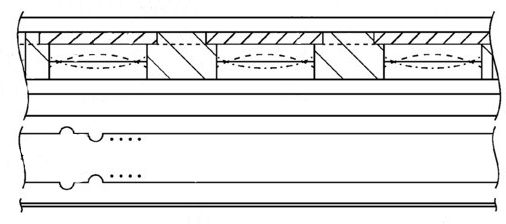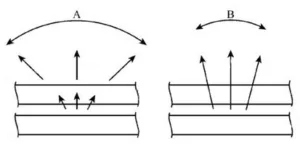Years ago, when LCDs were first introduced into commercial products, the display typically had a narrow angle of view. One aspect of this seeming limitation could actually be thought of as a feature.

A narrow angle of view provided the user with a means to maintain privacy by limiting the ability of others to see what was presented on the display. This effect is illustrated in the figure below.Left: wide viewing angle for normal use. Right: narrow viewing angle for privacy mode.
That was then. Now, LCDs have a very wide angle of view. There is, therefore, a desire to provide users with a means to achieve privacy whenever such privacy is desired.
One common, commercially available means to narrow the viewing angle is to place a louvred filter on the front of the display. As a practical matter, such an approach can be inconvenient since it requires mounting and demounting a separately carried accessory component. The filter may also reduce image brightness and/or color fidelity.
A patent application recently published by Apple Inc. (Cupertino, CA) discloses several new means to address the privacy issue. The patent application is entitled “Displays With Adjustable Angles-of-View.” Filed on June 30, 2016, it was just published on August 3, 2017. A copy of the published application, assigned number 2017-0219859, can be found here. The inventors are Miguel C. Christophy and Ming Xu.
In these new approaches, rather than a non-adjustable, temporary filter, the display itself has an electronic, user controlled privacy technology directly integrated into the display module. Paraphrasing the abstract of the patent application, the approaches can be summarized as follows.
- The liquid crystal module contains a backlight. An array of liquid lenses or liquid crystal lenses are sandwiched between substrate layers and the polarizing layers. This is illustrated in the figure below.
 Cross section of a LCD including liquid lenses for control of the viewing angle.
Cross section of a LCD including liquid lenses for control of the viewing angle.
By electronically adjusting the lenses, the angles of light rays from the backlight unit may also be adjusted so as to modify the angle of view of the display.
- An electrically controllable filter layer may have a liquid crystal layer or a polymer dispersed liquid crystal layer that can be electronically controlled. When a voltage is applied, portions of the filter layer change to a dark or translucent state and restrict the angle of view of the display.
- The liquid crystal layer may also contain a color filter layer to selectively omit or include images on the screen for wider viewing containing a particular color.
It can be noted that applications of Apple privacy technologies are not limited to just the devices in the company’s own product line.
Putting aside any effects that the Apple technologies to decrease the angle of view might have on image quality, their implementation would add to the thickness and weight of the display module, require additional power and add cost. So, clearly, there are still trade-offs involved even with the implementation of these new technologies. –Arthur Berman

